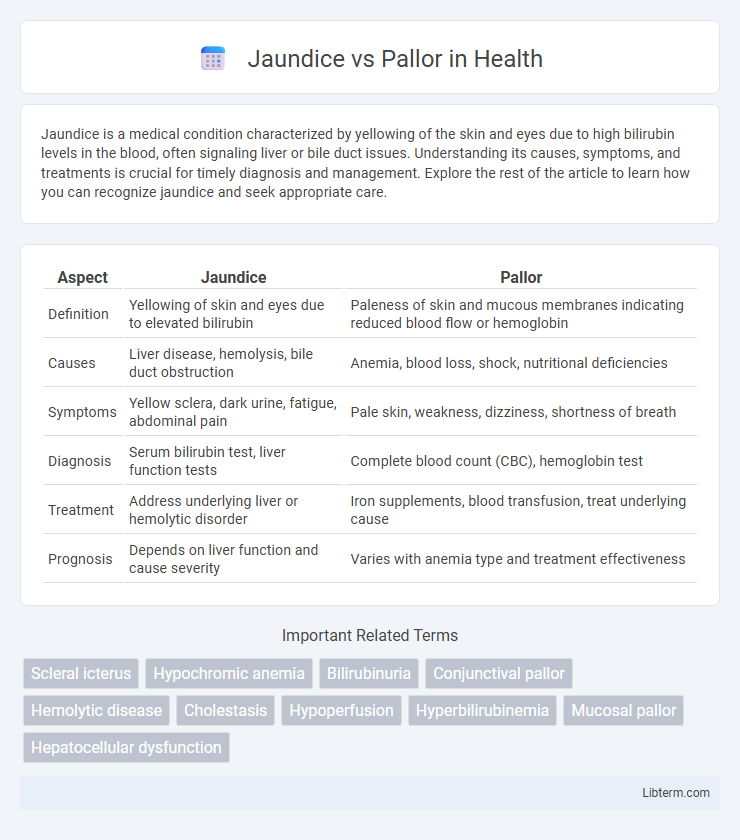Jaundice is a medical condition characterized by yellowing of the skin and eyes due to high bilirubin levels in the blood, often signaling liver or bile duct issues. Understanding its causes, symptoms, and treatments is crucial for timely diagnosis and management. Explore the rest of the article to learn how you can recognize jaundice and seek appropriate care.
Table of Comparison
| Aspect | Jaundice | Pallor |
|---|---|---|
| Definition | Yellowing of skin and eyes due to elevated bilirubin | Paleness of skin and mucous membranes indicating reduced blood flow or hemoglobin |
| Causes | Liver disease, hemolysis, bile duct obstruction | Anemia, blood loss, shock, nutritional deficiencies |
| Symptoms | Yellow sclera, dark urine, fatigue, abdominal pain | Pale skin, weakness, dizziness, shortness of breath |
| Diagnosis | Serum bilirubin test, liver function tests | Complete blood count (CBC), hemoglobin test |
| Treatment | Address underlying liver or hemolytic disorder | Iron supplements, blood transfusion, treat underlying cause |
| Prognosis | Depends on liver function and cause severity | Varies with anemia type and treatment effectiveness |
Understanding Jaundice: Definition and Causes
Jaundice is characterized by the yellowing of the skin, mucous membranes, and eyes due to elevated bilirubin levels in the blood, often resulting from liver dysfunction, hemolysis, or bile duct obstruction. Pallor, on the other hand, refers to an abnormal paleness of the skin typically caused by reduced blood flow or decreased red blood cell count, such as in anemia or shock. Understanding jaundice involves recognizing its biochemical basis in bilirubin metabolism and identifying underlying causes like hepatitis, gallstones, or hemolytic diseases.
What Is Pallor? Key Features and Origins
Pallor is characterized by an abnormal lightness of the skin and mucous membranes due to reduced oxyhemoglobin levels or decreased blood flow to the skin. Key features include pale or ashen skin, often observable on the face, palms, and conjunctiva, and it commonly indicates anemia, shock, or peripheral vasoconstriction. The condition originates from factors such as decreased red blood cell count, hemoglobin concentration, or compromised circulation, setting it apart from jaundice, which results from bilirubin accumulation.
Comparing Symptoms: Jaundice vs Pallor
Jaundice presents with yellowing of the skin and sclera caused by elevated bilirubin levels, often accompanied by dark urine and pale stools, while pallor involves unusually pale skin or mucous membranes due to reduced blood flow or hemoglobin concentration, commonly linked to anemia. Jaundice symptoms include itchiness and abdominal discomfort, whereas pallor symptoms primarily involve fatigue and shortness of breath. Both conditions indicate underlying health issues but differ significantly in their visible manifestations and associated clinical signs.
Underlying Medical Conditions for Jaundice
Jaundice manifests due to elevated bilirubin levels caused by underlying medical conditions such as hepatitis, liver cirrhosis, gallstones obstructing bile ducts, or hemolytic anemia. These conditions impair bilirubin metabolism, leading to yellowing of the skin and eyes, distinguishing jaundice from pallor, which results from reduced hemoglobin or red blood cell counts typically caused by anemia. Understanding these pathological differences is crucial for accurate diagnosis and targeted treatment.
Common Diseases Leading to Pallor
Pallor commonly results from anemia, which is often caused by iron deficiency, chronic disease, or acute blood loss, leading to reduced hemoglobin and diminished oxygen delivery to tissues. Other diseases contributing to pallor include leukemia, where bone marrow failure reduces red blood cell production, and hypothyroidism, which decreases metabolic activity and blood flow, causing pale skin. Unlike jaundice that involves bilirubin buildup causing yellow skin discoloration, pallor reflects inadequate red blood cells or hemoglobin without changes in bilirubin levels.
Diagnostic Approaches for Jaundice and Pallor
Diagnostic approaches for jaundice primarily involve serum bilirubin tests to measure total and direct bilirubin levels, liver function tests (LFTs), and imaging techniques such as ultrasound to identify biliary obstruction or liver pathology. In contrast, pallor diagnosis centers on complete blood count (CBC) to detect anemia types, reticulocyte count, and iron studies including serum ferritin and transferrin saturation to determine iron deficiency or other hematologic disorders. Physical examination findings complement laboratory diagnostics, with scleral icterus indicating jaundice and mucous membrane pallor signaling anemia.
Skin and Eye Changes: How to Differentiate
Jaundice presents with yellowing of the skin and sclera due to elevated bilirubin levels, often indicating liver dysfunction or hemolysis. Pallor is characterized by an abnormal lightness of the skin and mucous membranes resulting from decreased hemoglobin or red blood cells, commonly linked to anemia. Differentiation relies on observing the sclera: jaundice causes yellow discoloration, whereas pallor does not affect scleral coloration.
Treatment Options for Jaundice vs Pallor
Treatment options for jaundice primarily include phototherapy, especially in neonatal cases, and addressing underlying causes such as liver disease or hemolysis with medications or surgery. Pallor treatment focuses on correcting the root causes like iron deficiency anemia through iron supplementation, vitamin B12 injections, or blood transfusions. Both conditions require accurate diagnosis to tailor appropriate interventions effectively.
Risk Factors and Prevention Strategies
Jaundice risk factors include liver disease, hemolysis, and viral infections such as hepatitis, while pallor is commonly linked to anemia, blood loss, and nutritional deficiencies like iron or vitamin B12 deficiency. Prevention strategies for jaundice focus on vaccination against hepatitis, regular liver function monitoring, and avoiding excessive alcohol intake; pallor prevention emphasizes balanced diets rich in iron and vitamins, timely treatment of chronic diseases, and routine blood screenings. Early detection and management of underlying causes significantly reduce complications related to both jaundice and pallor.
When to Seek Medical Attention: Jaundice or Pallor
Seek immediate medical attention for jaundice if yellowing of the skin or eyes rapidly worsens, is accompanied by dark urine, pale stools, or abdominal pain, which may indicate liver disease or bile duct obstruction. Pallor that appears suddenly, especially with symptoms like fatigue, dizziness, or shortness of breath, requires urgent evaluation to rule out anemia, blood loss, or cardiovascular issues. Persistent or unexplained jaundice or pallor should prompt a healthcare consultation to determine underlying causes and appropriate treatment.
Jaundice Infographic

 libterm.com
libterm.com